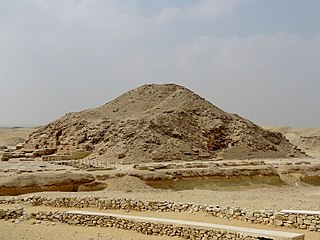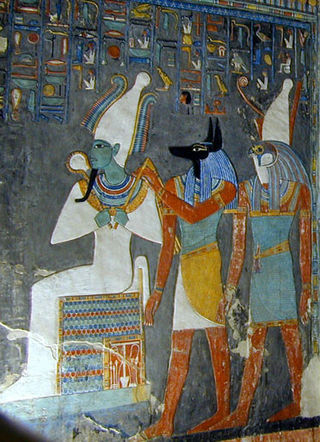Related Research Articles

The Osiris myth is the most elaborate and influential story in ancient Egyptian mythology. It concerns the murder of the god Osiris, a primeval king of Egypt, and its consequences. Osiris's murderer, his brother Set, usurps his throne. Meanwhile, Osiris's wife Isis restores her husband's body, allowing him to posthumously conceive their son, Horus. The remainder of the story focuses on Horus, the product of the union of Isis and Osiris, who is at first a vulnerable child protected by his mother and then becomes Set's rival for the throne. Their often violent conflict ends with Horus's triumph, which restores maat to Egypt after Set's unrighteous reign and completes the process of Osiris's resurrection.
A nomarch was a provincial governor in ancient Egypt; the country was divided into 42 provinces, called nomes. A nomarch was the government official responsible for a nome.

Sobekneferu or Neferusobek was a pharaoh of ancient Egypt and the last ruler of the Twelfth Dynasty of the Middle Kingdom. She ascended to the throne following the death of Amenemhat IV, possibly her brother or husband, though their relationship is unproven. Instead, she asserted legitimacy through her father Amenemhat III. Her reign lasted 3 years, 10 months, and 24 days, according to the Turin King List.

The Fifth Dynasty of ancient Egypt is often combined with Dynasties III, IV and VI under the group title the Old Kingdom. The Fifth Dynasty pharaohs reigned for approximately 150 years, from the early 25th century BC until the mid 24th century BC.

The Sixth Dynasty of ancient Egypt, along with the Third, Fourth and Fifth Dynasty, constitutes the Old Kingdom of Dynastic Egypt.

Amenemhat I, also known as Amenemhet I, was a pharaoh of ancient Egypt and the first king of the Twelfth Dynasty of the Middle Kingdom.

The tyet, sometimes called the knot of Isis or girdle of Isis, is an ancient Egyptian symbol that came to be connected with the goddess Isis. Its hieroglyphic depiction is catalogued as V39 in Gardiner's sign list.

Senusret II was the fourth pharaoh of the Twelfth Dynasty of Egypt. He ruled from 1897 BC to 1878 BC. His pyramid was constructed at El-Lahun. Senusret II took a great deal of interest in the Faiyum oasis region and began work on an extensive irrigation system from Bahr Yussef through to Lake Moeris through the construction of a dike at El-Lahun and the addition of a network of drainage canals. The purpose of his project was to increase the amount of cultivable land in that area. The importance of this project is emphasized by Senusret II's decision to move the royal necropolis from Dahshur to El-Lahun where he built his pyramid. This location would remain the political capital for the 12th and 13th Dynasties of Egypt. Senusret II was known by his prenomen Khakheperre, which means "The Ka of Re comes into being". The king also established the first known workers' quarter in the nearby town of Senusrethotep (Kahun).
Donald Bruce Redford is a Canadian Egyptologist and archaeologist, currently Professor of Classics and Ancient Mediterranean Studies at Pennsylvania State University. He is married to Susan Redford, who is also an Egyptologist currently teaching classes at the university. Professor Redford has directed a number of important excavations in Egypt, notably at Karnak and Mendes.

The pyramid of Neferirkare was built for the Fifth Dynasty pharaoh Neferirkare Kakai in the 25th century BC. It was the tallest structure on the highest site at the necropolis of Abusir, found between Giza and Saqqara, and still towers over the necropolis. The pyramid is also significant because its excavation led to the discovery of the Abusir Papyri.

Seuserenre Khyan (also Khayan or Khian was a Hyksos king of the Fifteenth Dynasty of Egypt, ruling over Lower Egypt in the second half of the 17th century BCE. His royal name Seuserenre translates as "The one whom Re has caused to be strong." Khyan bears the titles of an Egyptian king, but also the title ruler of the foreign land. The later title is the typical designation of the Hyksos rulers.

Nebka is the throne name of an ancient Egyptian pharaoh of the Third Dynasty during the Old Kingdom period, in the 27th century BCE. He is thought to be identical with the Hellenized name Νεχέρωχις recorded by the Egyptian priest Manetho of the much later Ptolemaic period.

The Oxford Companion to Food is an encyclopedia about food. It was edited by Alan Davidson and published by Oxford University Press in 1999. It was also issued in softcover under the name The Penguin Companion to Food. The second and third editions were edited by Tom Jaine and published by Oxford in 2006 and 2014.

Ancient Egyptian deities are the gods and goddesses worshipped in ancient Egypt. The beliefs and rituals surrounding these gods formed the core of ancient Egyptian religion, which emerged sometime in prehistory. Deities represented natural forces and phenomena, and the Egyptians supported and appeased them through offerings and rituals so that these forces would continue to function according to maat, or divine order. After the founding of the Egyptian state around 3100 BC, the authority to perform these tasks was controlled by the pharaoh, who claimed to be the gods' representative and managed the temples where the rituals were carried out.
The Dartmouth Medal of the American Library Association is awarded annually to a reference work of outstanding quality and significance, published during the previous calendar year.

The Oxford Encyclopedia of Maritime History, written by University of Oxford editor in chief John B. Hattendorf, was published by the Oxford University Press in 2007. The encyclopedia was issued in four volumes available in the Oxford Digital Library. The encyclopedia contains more than 950 articles devoted to global maritime history.

Egyptian mythology is the collection of myths from ancient Egypt, which describe the actions of the Egyptian gods as a means of understanding the world around them. The beliefs that these myths express are an important part of ancient Egyptian religion. Myths appear frequently in Egyptian writings and art, particularly in short stories and in religious material such as hymns, ritual texts, funerary texts, and temple decoration. These sources rarely contain a complete account of a myth and often describe only brief fragments.
The Temple of Satet or Satis was an ancient Egyptian temple dedicated to the goddess Satet, a personification of the Nile inundation. The temple was located on the Nile Valley island of Elephantine, Egypt. Founded during the late Predynastic Period around 3200 BC, it was enlarged and renovated several times from the Early Dynastic Period onwards over the next 3000 years until the Ptolemaic Period. The temple of Satet is the best example of an ancient Egyptian temple whose construction is attested over the entire pharaonic period.
Minnefer was an Ancient Egyptian official in the reign of king Nyuserre Ini. He bears the titles of a vizier and was therefore the highest official at the royal court, second only to the king. He was also overseer of all royal works, a title often held by viziers. Minnefer is known from different sources. He is depicted in the funerary temple of king Nyuserre Ini at Abusir providing firm evidence for his dating under this king. He is named on a short quarry-mark painted on a stone that was found in a wall around the pyramid complex of king Neferirkare Kakai. He is mentioned in papyri found at Abusir, that dates under Djedkare Isesi. He is also known from his sarcophagus that is now in the Rijksmuseum van Oudheden in Leiden. His mastaba was found at Saqqara. It is not yet published. The quarry marks on the pyramid of Neferirkare Kakai indicate that he helped building his pyramid. Neferirkare Kakai ruled before Nyuserre. That means that Minnefer was either very long in office, or that the pyramid complex was finished under Nyuserre. The reference under king Djedkare Isesi refers to a phyle named after Minnefer. That might indicate that the vizier was later honored, perhaps with the cult of a statue.

The pyramid of Senusret II at El Lahun is the pyramid complex constructed for the pharaoh Senusret II in the Twelfth Dynasty.
References
- ↑ Redford, Donald B. (11 January 2001). Description: The Oxford Encyclopedia of Ancient Egypt (3-Volume Set ed.). USA: Oxford University Press. ISBN 0195102347.
- ↑ The Oxford Encyclopedia of Ancient Egypt. OxfordReference.com. 2001. ISBN 978-0-19-510234-5.
- ↑ The Oxford Encyclopedia of Ancient Egypt. OxfordReference.com. 2001. ISBN 978-0-19-510234-5.
- ↑ "Dartmouth Medal: RUSA Awards: Award Recipients". American Library Association. 2002.
- ↑ The Oxford Encyclopedia of Ancient Egypt. OxfordReference.com. 2001. ISBN 978-0-19-510234-5.